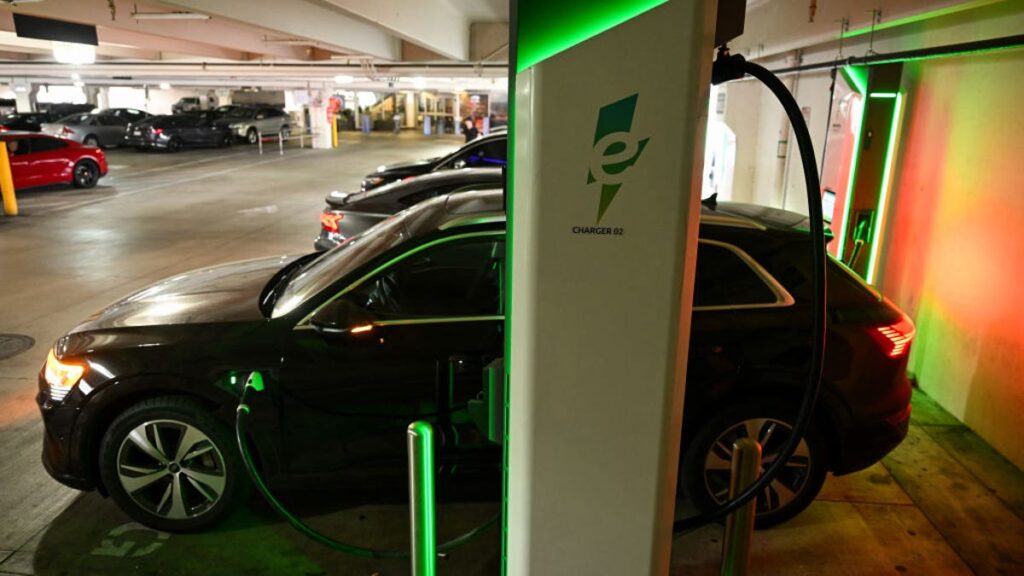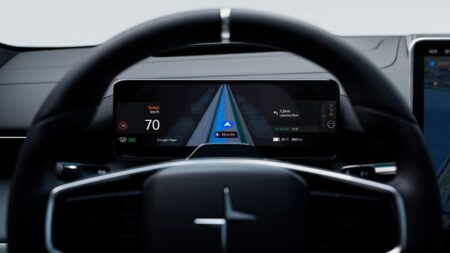The federal government’s $7,500 discount on electric vehicles has officially ended, which significantly changes the math of EV ownership — and might make you wonder if it’s more economical to buy a gas-powered car now.
This is a fair question, but the sticker price of a car (and the lack of a government rebate) is only one piece of the total cost of vehicle ownership, which also includes fuel costs, maintenance and depreciation.
When you take that all into account, EVs are still usually cheaper to own in the long run, according to auto experts. We did the math to show you how the costs break down, and how you can make an accurate comparison before making your next car purchase.
Comparing the upfront costs of an EV, hybrid and gasoline car
The sticker price is what most people think about when they compare the prices of different cars. From that perspective, the disappearance of the $7,500 federal EV tax credit puts EVs at a significant disadvantage on upfront costs when compared to gasoline or passive-hybrid cars.
When it comes to upfront costs, we’ve mapped out the winner, loser and runner-up:┬Ā
|
Winner ¤Åå |
Internal combustion engine vehicles |
Traditional gasoline cars usually have the lowest sticker price compared to their electrified counterparts. These types of vehicles have long-established supply chains and economies of scale that make them cheaper to manufacture, according to Antuan Goodwin, CNET’s EV senior writer. |
|
Runner-up ┬Ā¤źł |
Hybrid vehicles |
Hybrid-electric vehicles often have a slight premium over ICE cars due to the dual gas and electric powertrain, but are usually still more affordable than most pure EVs. ┬Ā |
|
Loser ¤ÆĖ |
Electric vehicles |
Electric cars are typically at the top end for sticker price. “The battery is going to be the biggest reason that EVs are more expensive,” Goodwin says. EVs also don’t benefit as much from economies of scale. Plus, consumers are still subsidizing the research and development that legacy automakers are doing to design electric cars, according to Amelia Dalgaard, an automotive expert known online as Motorhead Mama. |
Comparing fuel and charging costs
You can’t control gas prices, but you can control how much you spend to fuel up.
This is where you start to see some of the biggest savings between EVs and gasoline vehicles. Here’s how the costs shake out:
|
Winner ¤Åå |
Electric vehicles |
The cost of charging an EV depends a lot on your local electricity rates, and on where you charge your vehicle. Charging at home with a Level 2 charger is usually the cheapest way to fuel your EV, while public Level 3 fast-chargers are usually the most expensive. Generally speaking, charging an EV at home is cheaper than fueling a comparable car with gasoline, according to Goodwin and Dalgaard. For that average 11,000 miles per year, at the national average electricity rate, you’d spend $550 on charging. |
|
Runner-up ¤źł |
Hybrid vehicles |
The fuel costs for passive hybrids are usually lower than regular ICE cars because they get better overall gas mileage. Some models, like the Toyota Prius, get an average 54 miles per gallon. So while their upfront cost might be higher than a pure gasoline car, hybrids have a much lower cost per mile, and therefore lower refueling costs. |
|
Loser ¤ÆĖ |
Internal combustion engine vehicles |
Gasoline is usually the more expensive way to fuel a car when compared to an electric battery. “Electricity has historically been less expensive than gasoline by a significant chunk,” Goodwin says. The average gasoline car gets 26 miles per gallon, which accounts to a $1,320 annual fuel cost for the average 11,000 miles driven per year. |
Maintenance and repair costs: Less is more
EVs are also a big winner for lower maintenance costs, which adds a nice bit of savings to their total cost of ownership. Here’s how they compare to gasoline cars:
|
Winner ¤Åå |
Electric vehicles |
Whereas gas engines have plenty of things that can break, electric powertrains hardly ever do. “Typically, it’s set it and forget it,” Goodwin says. (No oil changes, spark plugs or exhaust system here.) That makes EV maintenance costs a lot lower than their gas counterparts. That being said, tires on EVs generally wear faster because the vehicle is heavier. And if you do need to make a significant repair on an EV (say, after a collision), it’s generally more expensive because the batteries and technology in an EV are costly to replace. |
|
Runner-up ¤źł |
Internal combustion engine vehicles |
Gasoline cars require a lot more maintenance than electric cars. That’s because gasoline engines have a lot more moving parts, and a lot more things that can break, compared to an electric powertrain. Regular oil and fluid changes, plus replacements of brakes and other mechanical parts, can add up to a lot of frequent maintenance costs. |
|
Loser ¤ÆĖ |
Hybrid vehicles |
Passive hybrid vehicles require basically all of the same maintenance that pure gasoline vehicles do, but maybe less often because the engine runs less of the time. Meanwhile, plug-in hybrids, which have both a full gasoline engine and a hefty electric battery powertrain, are basically the worst of both worlds when it comes to maintenance costs, Dalgaard says. |
Comparing insurance costs
Insurance is yet another ongoing cost that you just can’t avoid — but different types of cars can mean your policy prices vary wildly.
Insurance costs vary a lot depending on the type of car you own. Here are the general trends for different vehicles:
|
Winner ¤Åå |
Internal combustion engine vehicles |
These usually have the lowest insurance costs, because they’re cheaper to replace and repair after collisions. |
|
Runner-up ¤źł |
Hybrid vehicles |
Generally, these cars are more expensive to insure compared to pure gasoline vehicles because they’re more expensive to begin with. |
|
Loser ¤ÆĖ |
Electric vehicles |
These cars are the most expensive to insure because they have the highest sticker price, and because components such as batteries are more expensive to replace, according to Goodwin and Dalgaard. |
Depreciation and resale value: The wild card
Depreciation — or how much your vehicle decreases in value over time — can have a huge impact on your total cost of ownership. That’s because when you go to sell your car, its residual value can make a big difference in how much money you lose in the transaction.┬Ā
Here’s the breakdown between gasoline and electric cars:
|
Winner ¤Åå |
Internal combustion engine vehicles |
Because gasoline cars have been around for so long, their resale value follows a predictable and well-established depreciation curve. Currently, that usually means ICE cars depreciate more slowly than electric cars. |
|
Runner-up ¤źł |
Hybrid vehicles |
These cars have traditionally held their value well due to strong demand and fuel efficiency. |
|
Loser ¤ÆĖ |
Electric vehicles |
Historically, EVs have experienced higher and faster depreciation than ICE vehicles. That’s partly because the EV technology improves so quickly (leading to better battery range and faster charging) that older models become undesirable more rapidly (very much like the old iPhone models, Dalgaard says). That said, as the EV market matures, this effect might begin to lessen, Goodwin observes, leading to better resale value for EVs. |
The verdict on total cost of ownership
I compared the total cost of ownership for the same car in its electric and gas-powered models to highlight the differences.
I did the math with a real example, comparing an electric and gasoline-powered version of the same car: the new 2026 release of the Chevrolet Equinox.
|
Auto Type |
Electric vehicles |
Gas-powered vehicles |
|---|---|---|
|
Brand/Model/Year |
2026 Chevrolet Equinox EV |
2026 Chevrolet Equinox |
|
MSRP (Sticker price) at purchase |
$36,495 |
$30,495 |
|
Fuel/Charging cost┬Ā |
$0.05 per mile |
$0.12 per mile |
|
Cost of gasoline or electricity |
$0.175 per kWh |
$3.20 per gallon (US average)┬Ā |
|
Maintenance costs┬Ā |
6 cents per mile┬Ā |
10 cents per mile┬Ā |
|
Cost over 5 Years┬Ā |
$42,792 |
$43,088 |
|
Cost over 10 Years |
$49,744 |
$56,994 |
|
Cost over 15 Years |
$57,420 |
$72,345 |
Winner: Electric vehicles ¤Åå
Loser: Internal combustion engine vehicles ¤ÆĖ
Even without the federal government’s $7,500 tax credit, EVs can still have a lower total cost of ownership than ICE cars.
“In general, you’re going to be better off with an EV,” Dalgaard says. That’s because even though EVs have a higher upfront cost, gasoline cars can have more than double the fuel costs, and significantly higher maintenance costs.
Hybrids, meanwhile, probably have an advantage over ICE vehicles (due to the improved gas mileage), and offer a good middle ground if you’re not ready for an EV.
Of course, the best choice for you is also going to depend on your driving habits: How much you drive, how long you plan to keep the car and whether you can charge an EV at home, for example.
“Now you have more of an ability to pick a powertrain that works for you,” Goodwin says of the current vehicle market.
You should run the numbers yourself using local electricity rates, gas prices and driving patterns. It’s complicated, but online calculators like this one from the NY Times can help you make the comparison.┬Ā
Read the full article here














